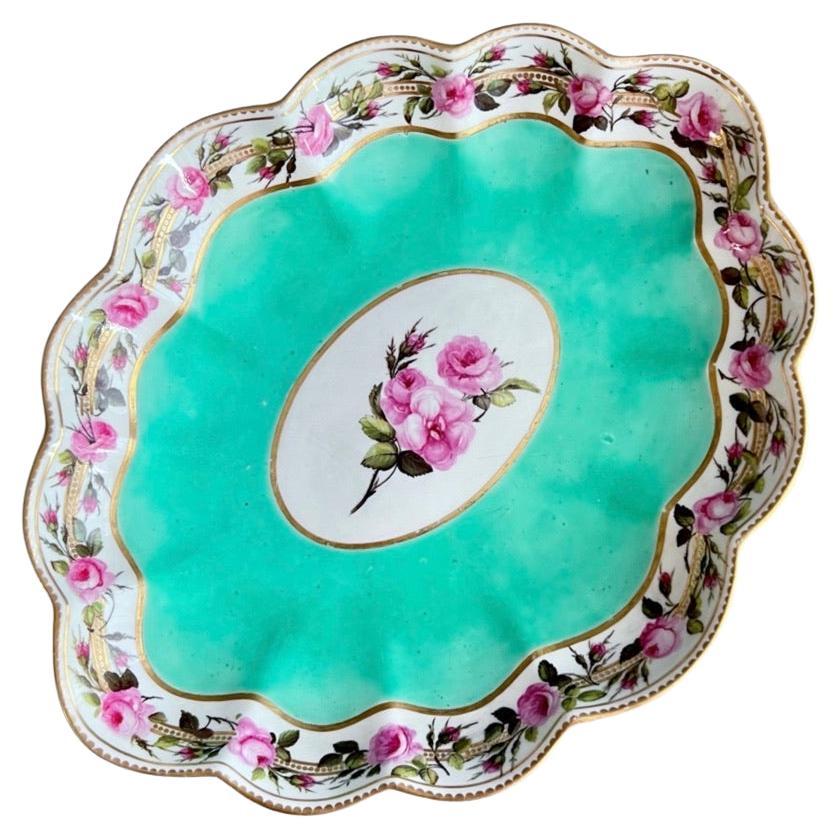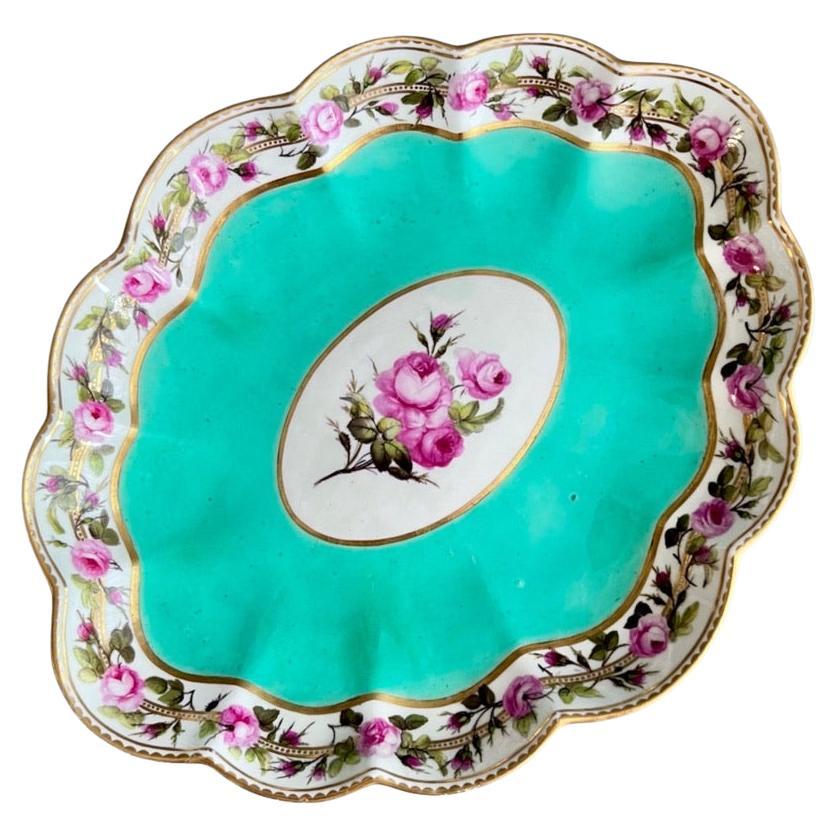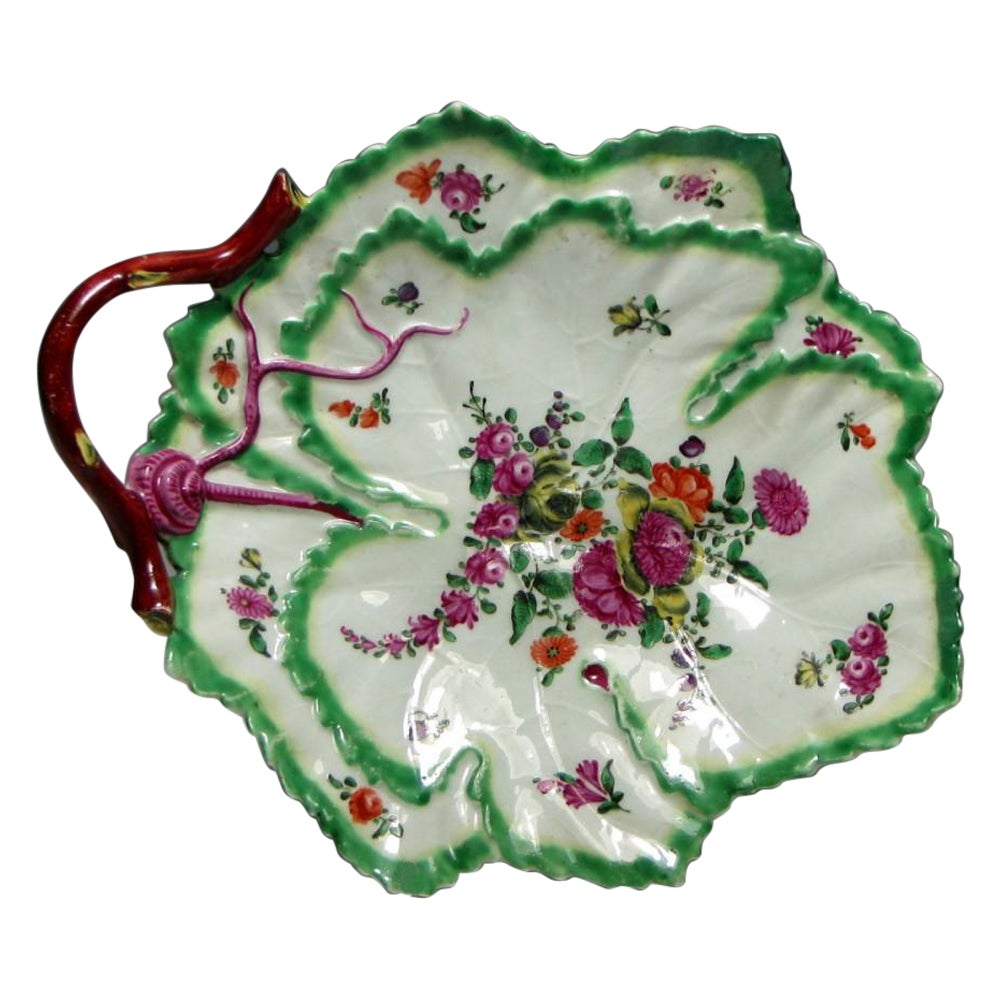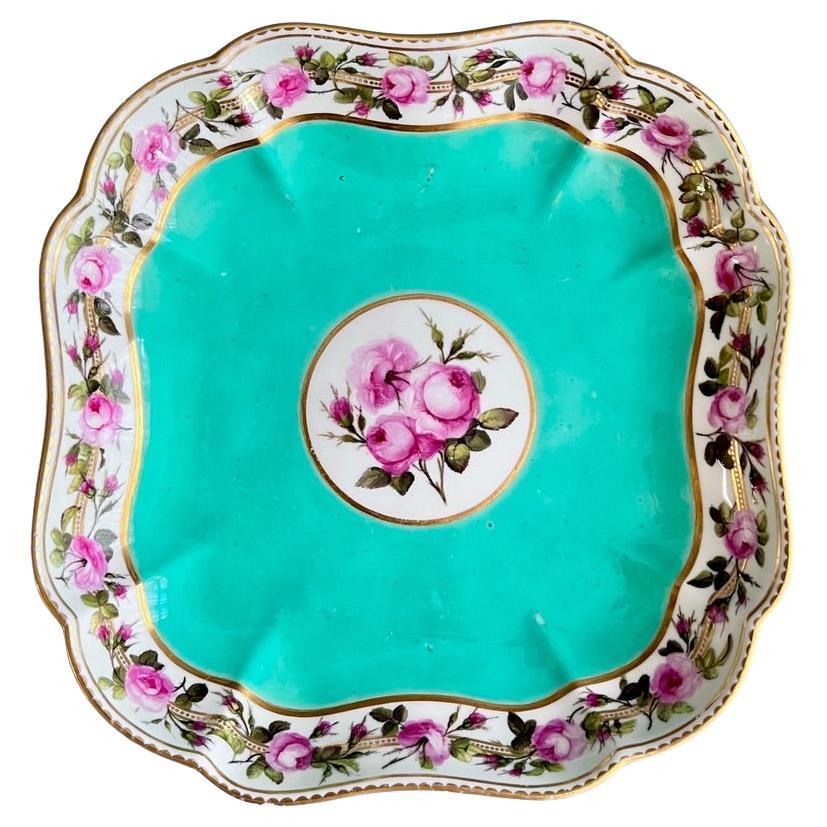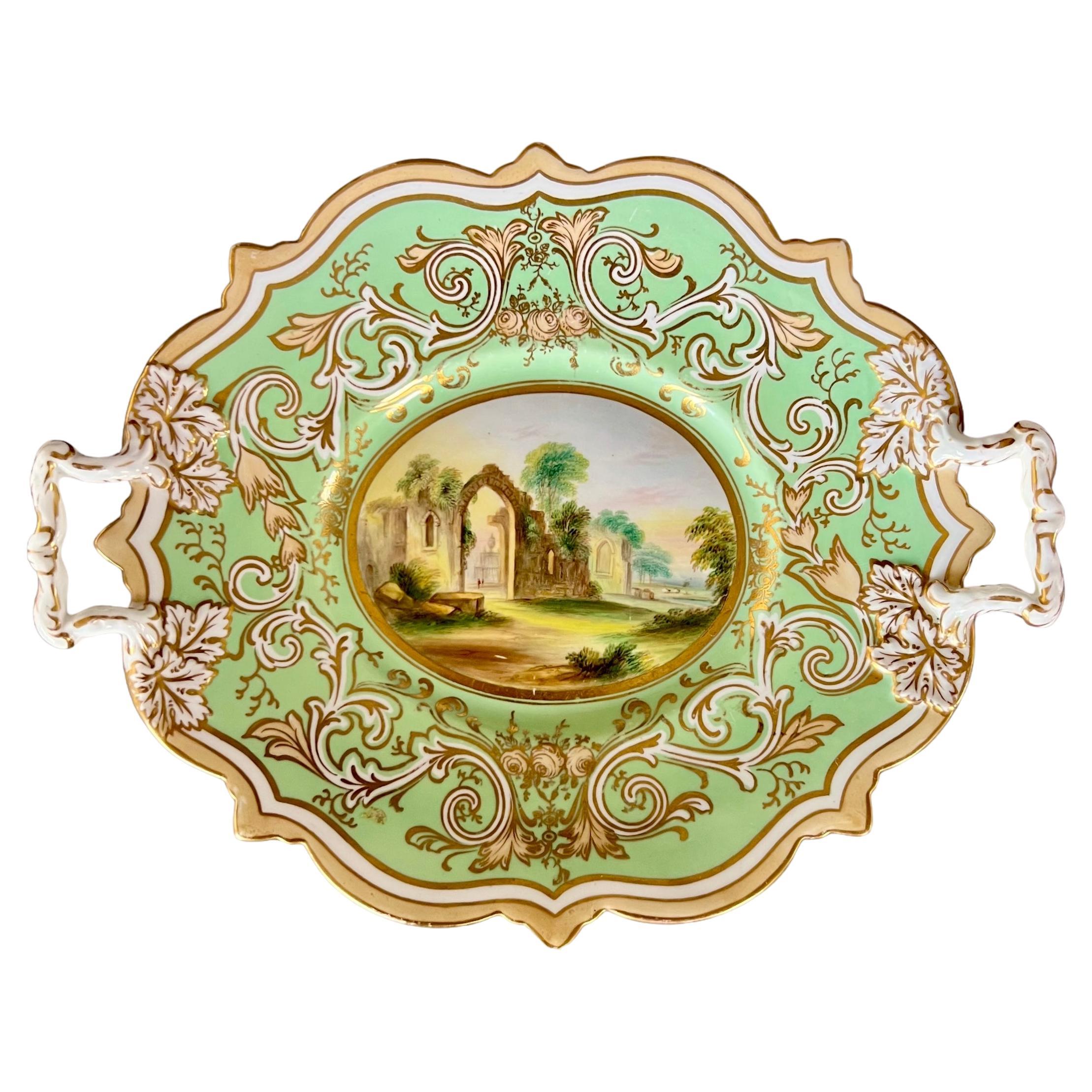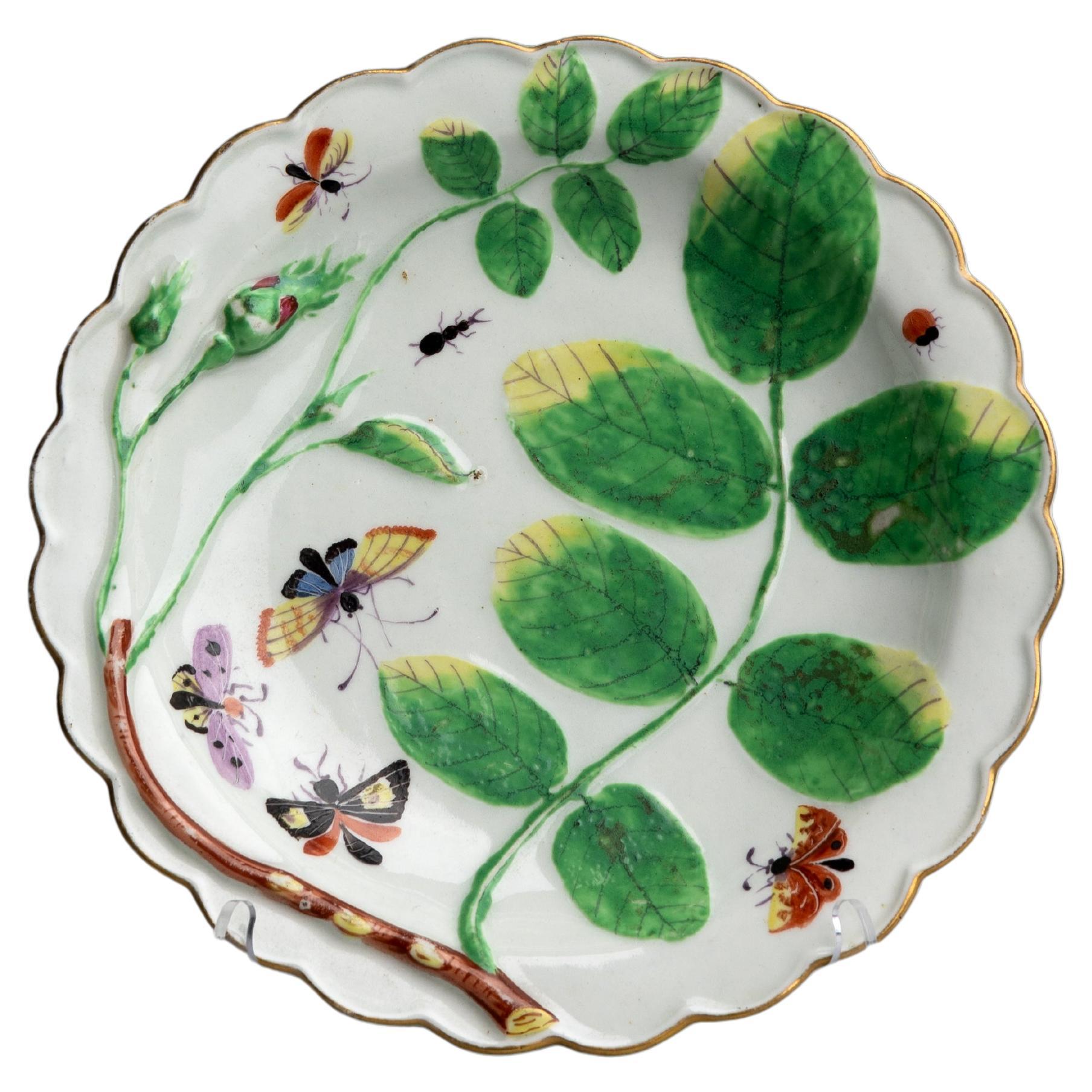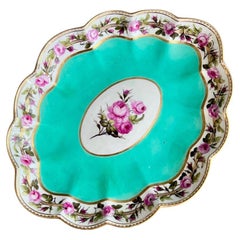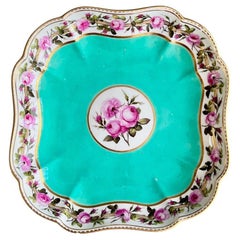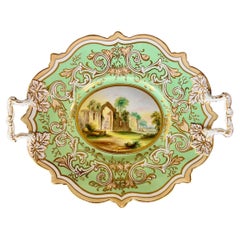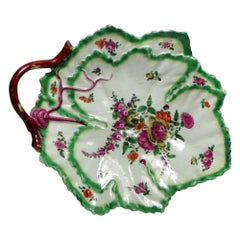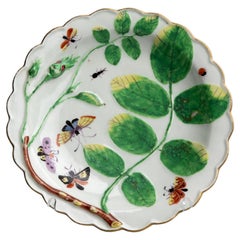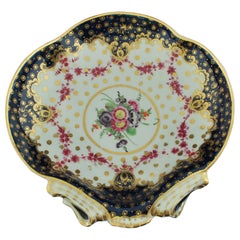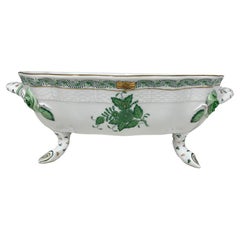Items Similar to Worcester Small Lobed Dish, Apple Green, Spotted Fruit James Giles, ca 1770
Want more images or videos?
Request additional images or videos from the seller
1 of 15
Worcester Small Lobed Dish, Apple Green, Spotted Fruit James Giles, ca 1770
$1,425
£1,077.12
€1,237.81
CA$1,984.30
A$2,207.46
CHF 1,157.18
MX$26,974.58
NOK 14,735.20
SEK 13,871.15
DKK 9,239.75
Shipping
Retrieving quote...The 1stDibs Promise:
Authenticity Guarantee,
Money-Back Guarantee,
24-Hour Cancellation
About the Item
This is a beautiful small deep plate made by Worcester in about 1770 in their First or the "Dr Wall" period. It is a small, lobed dish with a deep green ground, elegant tooled gilding and the famous "spotted fruit" decoration by the James Giles studio in London.
Worcester was one of the first potteries in Britain to create items in porcelain. Alongside other great potteries such as Derby, Chelsea and Bow, they pioneered a new industry that would grow out to be huge in the following century. This item is from the first period, which is often called the "Dr Wall" period after its founder. In later years Worcester went through many different ownerships and styles, and ultimately it became the Royal Worcester factory that only finished operation in the early 21st Century.
This beautiful dish has an overglaze deep green ground, which Worcester called "apple green", although today we would probably call it emerald green, in an unpredictable Rococo shape bordered with elegant slightly tooled gilt. The fruit painting in the centre was done in the famous studio of James Giles in London, and this style is called the "spotted fruit" style; you can see very realistic fruits such as grapes, peaches and even a blueberry, all slightly spotted and with some tiny fruit flies.
James Giles, who ran a large decorating studio in London, bought stock from Derby, Worcester and others, but also decorated for these factories. In 1771, Worcester terminated their contract with Giles, as their owner Dr Wall became increasingly nervous about Giles's success and his crossover with other factories. He knew this would leave Giles in a vulnerable position. As Giles was more of an artist than a salesman, he was forced to sell his stock in 1774 and in 1776 he closed due to bankruptcy. Most of his workers ended up being poached by the Derby and Worcester factories, considerably strengthening their won workforces.
An image of a trio in the same pattern can be found in plate 251 on page 219 from "Worcester Porcelain 1751-1790 The Zorensky Collection" by Simon Spero and John Sandon.
The plate is not marked, as is not uncommon for the period, but it has two old trader's labels: one with a slightly wrong dating (1760) and a US sale price ($750), the other an old BADA export label.
CONDITION REPORT The plate is in excellent antique condition without any damage, repairs, crazing and has some minor rubbing and knife scratches, as visible in the pictures.
Antique British porcelain is never perfect. Kilns were fired on coal in the 1700s, and this meant that china from that period can have some firing specks from flying particles. British makers were also known for their experimentation, and sometimes this resulted in technically imperfect results. Due to the shrinkage in the kiln, items can have small firing lines or develop crazing over time, which should not be seen as damage but as an imperfection of the maker's recipes, probably unknown at the time of making. Items have often been used for many years and can have normal signs of wear, and gilt can have signs of slight disintegration even if never handled. I will reflect any damage, repairs, obvious stress marks, crazing or heavy wear in the item description but some minor scratches, nicks, stains and gilt disintegration can be normal for vintage items and need to be taken into account.
There is widespread confusion on the internet about the difference between chips and nicks, or hairlines and cracks. I will reflect any damage as truthfully as I can, i.e. a nick is a tiny bit of damage smaller than 1mm and a chip is something you can easily see with the eye; a glazing line is a break in the glazing only; hairline is extremely tight and/or superficial and not picked up by the finger; and a crack is obvious both to the eye and the finger. Etcetera - I try to be as accurate as I can and please feel free to ask questions or request more detailed pictures!
DIMENSIONS (diameter) 18.8cm (7.4")
- Creator:1st Period Worcester Dr. Wall (Maker),James Giles (Artist)
- Dimensions:Height: 1 in (2.54 cm)Diameter: 7.4 in (18.8 cm)
- Style:George III (Of the Period)
- Materials and Techniques:
- Place of Origin:
- Period:1770-1779
- Date of Manufacture:circa 1770
- Condition:Wear consistent with age and use. in excellent antique condition without any damage, repairs, crazing and has some minor rubbing and knife scratches.
- Seller Location:London, GB
- Reference Number:Seller: HP-WOR051stDibs: LU4805141869262
About the Seller
5.0
Gold Seller
Premium sellers maintaining a 4.3+ rating and 24-hour response times
Established in 2016
1stDibs seller since 2019
225 sales on 1stDibs
- ShippingRetrieving quote...Shipping from: London, United Kingdom
- Return Policy
Authenticity Guarantee
In the unlikely event there’s an issue with an item’s authenticity, contact us within 1 year for a full refund. DetailsMoney-Back Guarantee
If your item is not as described, is damaged in transit, or does not arrive, contact us within 7 days for a full refund. Details24-Hour Cancellation
You have a 24-hour grace period in which to reconsider your purchase, with no questions asked.Vetted Professional Sellers
Our world-class sellers must adhere to strict standards for service and quality, maintaining the integrity of our listings.Price-Match Guarantee
If you find that a seller listed the same item for a lower price elsewhere, we’ll match it.Trusted Global Delivery
Our best-in-class carrier network provides specialized shipping options worldwide, including custom delivery.More From This Seller
View AllDerby Lobed Dish, Camden Service, William Billingsley Roses on Green, 1795 (1)
By Derby
Located in London, GB
This is a very rare oval lobed dish from the famous "Earl of Camden" service made by the Derby Porcelain Company in 1795. The service was painted with typical English roses by William Billingsley, one of Britain's most famous painters, and responsible for exactly this type of rose painting on British porcelain.
There are more items available in this pattern, see separate listings. To keep these items together we'd be happy to offer a discount on multiple purchases - please ask!
The Derby Porcelain Company, later called Royal Crown Derby, is currently the oldest British porcelain factory still in production. The Derby pottery was one of the most prominent potteries right from the start of English porcelain production in the mid 1700s to today, and the factory went through many iterations. In the 1820s, it was called "Bloor Derby" as it came under the ownership of Robert Bloor; this factory later closed but its legacy was continued under the ownership of a group of employees, and later this was merged into a new factory called Royal Crown Derby, which is still in operation today and still carries forward some of the oldest patterns that have made it famous over the centuries.
William Billingsley was a brilliant but notoriously difficult man who left behind a trail of debts, broken hearts and mystery - but he was also one of the most important people in the history British porcelain. Billingsley revolutionised the way British decorators painted flowers; he added a freedom and artistry that now singles out British flower painting, and he created a new technique for painting roses, which you can see in this design. Billingsley worked at Derby, Worcester and Mansfield. He also set up his own potteries in Pinxton and Nantgarw and created some of the best porcelain ever made, but racking up great debts, before running off in the dead of night and ending his days at Coalport painting flowers.
Items painted by William Billingsley are rare and very much in demand - together with Thomas Baxter's work they are probably among the most desired pieces of British porcelain.
The Earl of Camden service was a huge service ordered by Lady Camden in 1795. It had to be produced under great, and unrealistic, time pressure and was notoriously late, much to Lady Camden's chagrin. She wanted the service to be produced by only the best artisans and therefore William Billingsley was tasked with painting all items - but it is thought that when it was clear the deadline was impossible to make, he enlisted the help of John Brewer for some of the last items, such as the ice pails. This plate shows the typical "Billingsley" roses: a beautiful naturally flowing garland of English roses interspersed with buds, trailing around a crisp gilt ribbon. The way the roses link into each other, the way each individual one is completely different, the light effects achieved by rubbing out some of the pink paint, and the very fine buds and foliage all point to these being from Billingsley's hand.
This dish came together with a plate that bears labels that point to a rich provenance: the Doris Wheatley Collection, the Daniel Collection, Derek Gardner...
Category
Antique 1790s English George III Serving Bowls
Materials
Porcelain
Derby Oval Dish, Camden Service, William Billingsley Roses on Green, 1795 (2)
By Derby
Located in London, GB
This is a very rare oval lobed dish from the famous "Earl of Camden" service made by the Derby Porcelain Company in 1795. The service was painted with typical English roses by William Billingsley, one of Britain's most famous painters, and responsible for exactly this type of rose painting on British porcelain.
There are more items available in this pattern, see separate listings. To keep these items together we'd be happy to offer a discount on multiple purchases - please ask!
The Derby Porcelain Company, later called Royal Crown Derby, is currently the oldest British porcelain factory still in production. The Derby pottery was one of the most prominent potteries right from the start of English porcelain production in the mid 1700s to today, and the factory went through many iterations. In the 1820s, it was called "Bloor Derby" as it came under the ownership of Robert Bloor; this factory later closed but its legacy was continued under the ownership of a group of employees, and later this was merged into a new factory called Royal Crown Derby, which is still in operation today and still carries forward some of the oldest patterns that have made it famous over the centuries.
William Billingsley was a brilliant but notoriously difficult man who left behind a trail of debts, broken hearts and mystery - but he was also one of the most important people in the history British porcelain. Billingsley revolutionised the way British decorators painted flowers; he added a freedom and artistry that now singles out British flower painting, and he created a new technique for painting roses, which you can see in this design. Billingsley worked at Derby, Worcester and Mansfield. He also set up his own potteries in Pinxton and Nantgarw and created some of the best porcelain ever made, but racking up great debts, before running off in the dead of night and ending his days at Coalport painting flowers.
Items painted by William Billingsley are rare and very much in demand - together with Thomas Baxter's work they are probably among the most desired pieces of British porcelain.
The Earl of Camden service was a huge service ordered by Lady Camden in 1795. It had to be produced under great, and unrealistic, time pressure and was notoriously late, much to Lady Camden's chagrin. She wanted the service to be produced by only the best artisans and therefore William Billingsley was tasked with painting all items - but it is thought that when it was clear the deadline was impossible to make, he enlisted the help of John Brewer for some of the last items, such as the ice pails. This plate shows the typical "Billingsley" roses: a beautiful naturally flowing garland of English roses interspersed with buds, trailing around a crisp gilt ribbon. The way the roses link into each other, the way each individual one is completely different, the light effects achieved by rubbing out some of the pink paint, and the very fine buds and foliage all point to these being from Billingsley's hand.
This dish came together with a plate that bears labels that point to a rich provenance: the Doris Wheatley Collection, the Daniel Collection, Derek Gardner...
Category
Antique 1790s English George III Serving Bowls
Materials
Porcelain
Derby Square Dish, Camden Service, William Billingsley Roses on Green, 1795
By Derby
Located in London, GB
This is a very rare square dish from the famous "Earl of Camden" service made by the Derby Porcelain Company in 1795. The service was painted with typical English roses by William Billingsley, one of Britain's most famous painters, and responsible for exactly this type of rose painting on British porcelain.
There are more items available in this pattern, see separate listings. To keep these items together we'd be happy to offer a discount on multiple purchases - please ask!
The Derby Porcelain Company, later called Royal Crown Derby, is currently the oldest British porcelain factory still in production. The Derby pottery was one of the most prominent potteries right from the start of English porcelain production in the mid 1700s to today, and the factory went through many iterations. In the 1820s, it was called "Bloor Derby" as it came under the ownership of Robert Bloor; this factory later closed but its legacy was continued under the ownership of a group of employees, and later this was merged into a new factory called Royal Crown Derby, which is still in operation today and still carries forward some of the oldest patterns that have made it famous over the centuries.
William Billingsley was a brilliant but notoriously difficult man who left behind a trail of debts, broken hearts and mystery - but he was also one of the most important people in the history British porcelain. Billingsley revolutionised the way British decorators painted flowers; he added a freedom and artistry that now singles out British flower painting, and he created a new technique for painting roses, which you can see in this design. Billingsley worked at Derby, Worcester and Mansfield. He also set up his own potteries in Pinxton and Nantgarw and created some of the best porcelain ever made, but racking up great debts, before running off in the dead of night and ending his days at Coalport painting flowers.
Items painted by William Billingsley are rare and very much in demand - together with Thomas Baxter's work they are probably among the most desired pieces of British porcelain.
The Earl of Camden service was a huge service ordered by Lady Camden in 1795. It had to be produced under great, and unrealistic, time pressure and was notoriously late, much to Lady Camden's chagrin. She wanted the service to be produced by only the best artisans and therefore William Billingsley was tasked with painting all items - but it is thought that when it was clear the deadline was impossible to make, he enlisted the help of John Brewer for some of the last items, such as the ice pails. This plate shows the typical "Billingsley" roses: a beautiful naturally flowing garland of English roses interspersed with buds, trailing around a crisp gilt ribbon. The way the roses link into each other, the way each individual one is completely different, the light effects achieved by rubbing out some of the pink paint, and the very fine buds and foliage all point to these being from Billingsley's hand.
This dish came together with a plate that bears labels that point to a rich provenance: the Doris Wheatley Collection, the Daniel Collection, Derek Gardner...
Category
Antique 1790s English George III Serving Bowls
Materials
Porcelain
Samuel Alcock Low Oval Comport Dish, Sage Green with Landscape, ca 1850
By Samuel Alcock & Co.
Located in London, GB
An oval low-footed comport with two handles and an octagonally scrolled shape, a moulded surface with pale yellow and white scrolling foliage on a sage green ground, and a stunning l...
Category
Antique 1850s English Victorian Serving Bowls
Materials
Porcelain
$600 Sale Price
20% Off
Free Shipping
Worcester Porcelain Plate, Flower Sprays by James Giles, ca 1770
By 1st Period Worcester Dr. Wall, James Giles
Located in London, GB
This is a beautiful large plate made by Worcester in about 1770 in their First or the "Dr Wall" period. The plate has a pleasing slightly lobed rim, a white ground and beautifully pa...
Category
Antique 1770s English George III Porcelain
Materials
Porcelain
Caughley Dish, Harlequin Pattern in Style of Donegall Service, ca 1793
By Chamberlains Worcester, Caughley Porcelain
Located in London, GB
This is a beautiful and intriguing porcelain dish made by Caughley and decorated at Chamberlains Worcester in or shortly after 1793. The dish has a "harlequin" pattern with six diffe...
Category
Antique 1790s English Neoclassical Porcelain
Materials
Porcelain
$1,120 Sale Price
20% Off
Free Shipping
You May Also Like
First Period Worcester Leaf Dish, 1765-1770
By 1st Period Worcester Dr. Wall
Located in Tunbridge Wells, GB
First Period Worcester Leaf Dish, 1765-1770
These large vine leaf shaped dishes were made as a component within a dessert service to serve sweetme...
Category
Antique 18th Century English George III Decorative Dishes and Vide-Poche
Materials
Porcelain
18th Century Worcester Blind Earl Porcelain Dish
By James Giles, 1st Period Worcester Dr. Wall
Located in Fort Lauderdale, FL
A Worcester Blind Earl porcelain plate made circa 1770 with beautifully enamelled decoration of butterflies and insects among raised leaf and rose...
Category
Antique 1770s English Rococo Porcelain
Materials
Porcelain
Dessert Dish, Worcester, circa 1770
By 1st Period Worcester Dr. Wall
Located in Melbourne, Victoria
A dessert dish, in the shape of a shell, and decorated in the Sevres manner.
Category
Antique Late 18th Century English Neoclassical Porcelain
Materials
Porcelain
Herend Hungary Porcelain "Chinese Bouquet Apponyi Green" Fruit Bowl
By Herend
Located in Delft, NL
Herend Hungary porcelain "Chinese Bouquet Apponyi Green" fruit bowl
Two handled footed fruit bowl with Chinese Bouquet Apponyi Green pattern and roses, raised on four branches feet....
Category
20th Century Hungarian Porcelain
Materials
Porcelain
19th Century Majolica Apples Plate Choisy Le Roi
By Choisy-le-Roi
Located in Austin, TX
19th century Majolica Apples plate signed Choisy Le Roi.
Made for Higgins & Seiter New York.
The Higgins & Seiter Company of New York City began selling decorations for the table, in...
Category
Antique 1880s French Rustic Dinner Plates
Materials
Ceramic
Antique 18th Century Dutch Delft or Samadet Green Faience Barber's Bowl
By Delft
Located in Bad Säckingen, DE
This exquisite 18th-century Dutch Delft or Samadet faience barber's bowl showcases a classic lobed shape with a notched rim, traditionally designed for shaving use. The piece is hand-painted in vibrant green with a central floral motif surrounded by delicate foliate designs, accentuated by a decorative border along the scalloped edge. The tin-glazed ceramic surface exhibits the characteristic craquelure and slight imperfections typical of early Delftware.
Originally used in barbershops for lathering and rinsing during shaves, this historical faience bowl is now a highly collectible decorative object, perfect for display in a Delftware collection or as a charming accent in a period interior.
A remarkable example of Dutch craftsmanship, this piece captures the elegance and functionality of antique Delftware.
Category
Antique Early 18th Century Dutch Baroque Decorative Bowls
Materials
Faience
More Ways To Browse
Green Glass Grapes
Antique Painting Tools
Chinese Emerald Green
Fruit Knife
Chelsea Plate
Spotted Glass
Grapes And Peaches
Silver Grape Pattern
Antique Flies
Grape Dish
Emerald Collection Made In China
Chinese Export Porcelain Fruit
Worcester Porcelain First Period
Antique Royal Worcester Patterns
Derby Chelsea
Lobed Dish
Antique Plates 1700s
Antique Silver Fruit Knife
